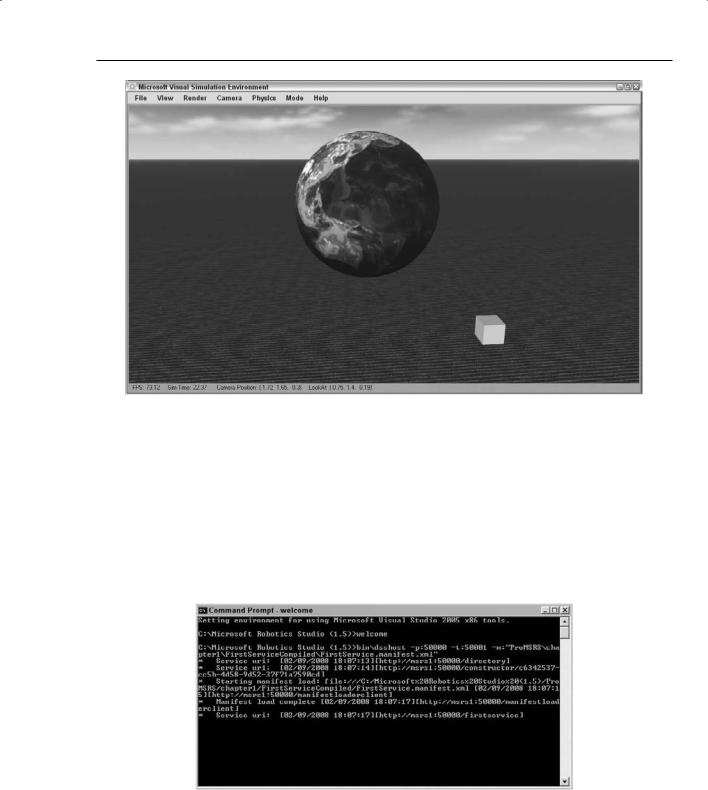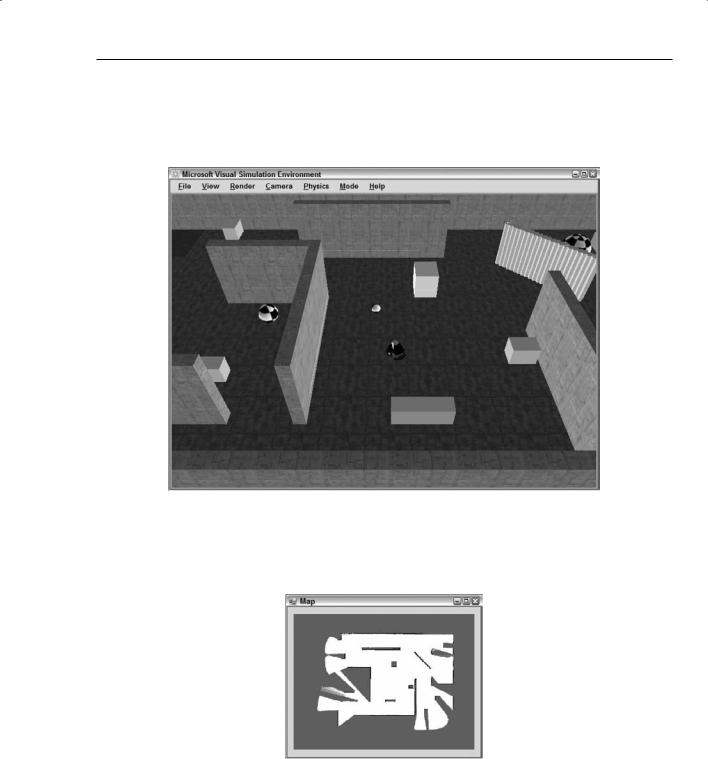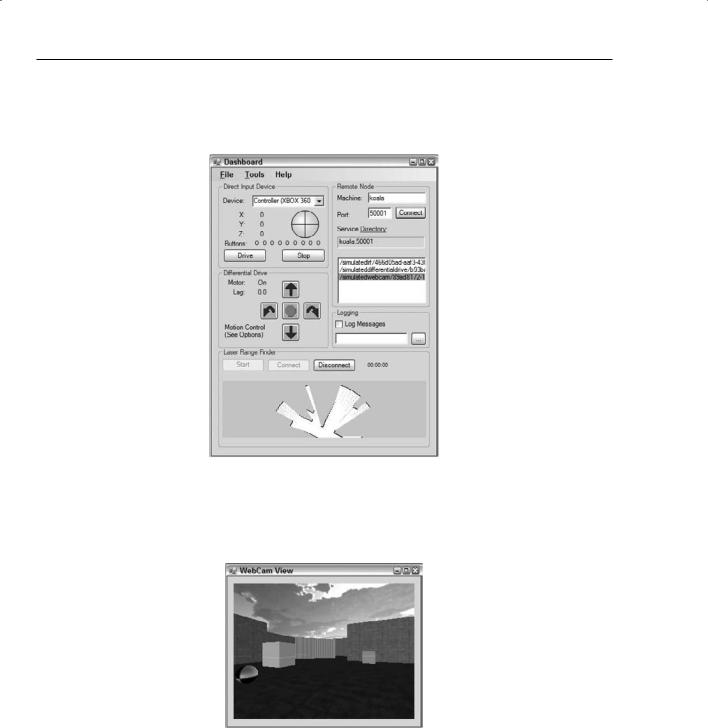
Задани на лабораторные работы. ПРК / Professional Microsoft Robotics Developer Studio
.pdf
www.it-ebooks.info
Chapter 1: Exploring Microsoft Robotics Developer Studio
Figure 1-16
If your window is red and contains an error message, shows a solid light-blue color, or looks substantially different from the scene shown in Figure 1-16, check the capabilities of your graphics card.
ProMRDS Sample Code
A very simple little sample program is provided to verify that you have properly installed the sample code associated with this book. Make sure that all DSS nodes have been terminated and then open an MRDS Command Prompt window and type Welcome, as shown in Figure 1-17.
Figure 1-17
23

www.it-ebooks.info
Part I: Robotics Developer Studio Fundamentals
You should see the output shown in Figure 1-17, and after a moment or two a dialog box similar to the one shown in Figure 1-18 should appear. If your speaker volume is on and speech services are correctly configured on your machine, you should hear the words in the dialog box spoken by the computer.
Figure 1-18
This verifies that the source code for the book was properly installed. Incidentally, that very simple service was generated with the VPL diagram shown in Figure 1-19. More great VPL examples can be found in Chapters 10 through 12. You can terminate the DSS node by pressing Ctrl+C in the Command Prompt window.
Figure 1-19
For an example that shows off the power of MRDS, try a different service. Follow these steps:
1. In Windows Explorer, navigate to the MRDS installation point and then to
ProMRDS\Chapter9\ExplorerSim.
24

www.it-ebooks.info
Chapter 1: Exploring Microsoft Robotics Developer Studio
2.
3.
Open ExplorerSim.sln in Visual Studio by double-clicking it.
Once it is open, run the service with the debugger by pressing F5 or clicking Debug  Start Debugging. After a little while, a DOS Command Prompt window appears, followed by a simulation window, shown in Figure 1-20.
Start Debugging. After a little while, a DOS Command Prompt window appears, followed by a simulation window, shown in Figure 1-20.
Figure 1-20
The simulated Pioneer 3DX robot wanders around building a map using information from the simulated laser range finder. You can see the map in the Map window. Figure 1-21 shows a map after the robot has done a fair amount of exploring.
Figure 1-21
A Dashboard window also appears when you run the service.
25

www.it-ebooks.info
Part I: Robotics Developer Studio Fundamentals
4. Enter localhost as the Machine and 50001 as the Port and click Connect. Three services are displayed in the service directory list. Double-click simulatedlrf to select it. Figure 1-22 shows the Dashboard with the Laser Range Finder information displayed.
Figure 1-22
5. Double-click the simulatedwebcam service. A webcam window pops up to show the robot’s view of the world (see Figure 1-23).
Figure 1-23
The ExplorerSim service illustrates many different aspects of MRDS and it is interesting to watch for a while. When you get tired of it, just stop the program in Visual Studio.
26

www.it-ebooks.info
Chapter 1: Exploring Microsoft Robotics Developer Studio
Additional Resources and Support
It should be clear at this point that there is a great deal to learn about Microsoft Robotics Developer Studio. This book gives you a great start, but it is best to take advantage of all the resources available. The following sections point out a few of these.
www.Microsoft.com/Robotics
This is Microsoft Robotics Developer Studio central. You can find information about the latest releases on this page along with pointers to many other articles and blogs written by other users. The Community link has links to partner websites where MRDS-related products are offered. There are also links to MRDS-related user groups and discussion boards.
On the main MRDS page, you can also find a link to the MRDS wiki, which contains hints, bug workarounds, and additional information about using MRDS.
Add this page to your Favorites list, as you will likely refer back to it often.
Tutorials and User Guides
Following a long Microsoft tradition, the early documentation provided with Microsoft Robotics Developer Studio was a little thin. It is rapidly becoming more complete and now includes several informative user guides along with the tutorials.
The MRDS documentation can be accessed from a link on the Start menu. The Samples and Tutorials Overview at the beginning of the documentation provides a good roadmap for exploring the tutorials. It is strongly recommended that you do all of the tutorials. Start with the DSS tutorials to learn service programming by example. These tutorials are good companion material to Chapters 2–4 in this book. Likewise, the Simulation tutorials provide a different view of the material in Chapters 5–9. The VPL tutorials go with the material in Chapters 10–12, and the Robotics tutorials supplement the information in Chapters 13–17.
In addition to the samples and tutorials, CCR and DSS each have a good User Guide that is available in the Microsoft Robotics Developer Studio Runtime section in the MRDS documentation.
Additional sections of interest include the Courseware section and the Technology Samples section.
Online Forums
Sometimes you might run into a problem that just can’t be answered by this book or the tutorials and samples. In this case, you should turn to the online forums. There is a link on the main MRDS page to get to the forums, or you can go directly to http://forums.microsoft.com/msdn/default
.aspx?forumgroupid=383&siteid=1.
The forums provide an opportunity to post questions in the following six categories:
Community: Samples, feedback, and general discussion
Concurrency and Coordination Runtime: Everything about the CCR
27

www.it-ebooks.info
Part I: Robotics Developer Studio Fundamentals
Decentralized Software Services: Everything about DSS
Simulation: Samples, entities, and graphics/physics discussion
Visual Programming Language: Everything about VPL
Hardware Configuration and Troubleshooting: How to set up your hardware and help with porting code to MRDS
Members of the MRDS team spend considerable time answering questions on the forums, and other users often contribute answers. It is worthwhile to search through past threads before posting a new question on the forums.
If you are posting code to the forum, try to condense it down to the shortest piece of code that illustrates the problem. Copy and paste it into the posting window, and then select it and mark it as code by clicking the Mark Code Block button in the editing toolbar. This prevents your code from appearing in the forum with a bunch of smiley faces in it.
Channel 9
Channel 9 is a Microsoft-sponsored developer community with many interesting links to other developers’ MRDS projects. The Channel 9 home page is http://channel9.msdn.com and from there you can click the Search link to search for videos, projects, and posts about MRDS. There are also links to several classic Channel 9 videos, available directly from the MRDS home page in the Featured Videos section.
Take a look at some of the projects presented and be sure to post your own project in the Sandbox when it is ready for the world to see.
Summary
So that’s Microsoft Robotics Developer Studio in a nutshell. Now that you’ve seen the opportunities that await you, it’s time to warm up your compiler and get coding. First one to write a sentient service wins!
28

www.it-ebooks.info
Concurrency and
Coordination Runtime (CCR)
Microsoft Robotics Developers Studio (MRDS) is built on two basic components: the Concurrency and Coordination Runtime (CCR) and the Decentralized Software Services (DSS). This chapter covers many of the concepts of the CCR; the next chapter discusses DSS.
To quickly clarify the differences between the CCR and DSS: The CCR is a programming model for handling multi-threading and inter-task synchronization, whereas DSS is used for building
applications based on a loosely coupled service model. Services can run anywhere on the network, so DSS provides a communications infrastructure that enables services to transparently run on different nodes using all of the same CCR constructs that they would use if they were running locally.
Although you can use the CCR on its own, completely outside MRDS, this is not how you use it for creating robotics applications. Consequently, there is some overlap with DSS in this chapter because it provides an environment that makes CCR easier to use. In fact, there was some discussion during the writing of this book regarding whether CCR or DSS should be covered first. You can take a peek at the next chapter and decide for yourself in which order you want to read them.
A large amount of documentation is supplied with MRDS and the authors do not intend to reproduce it all here. You should read the online CCR User Guide (http://msdn2.microsoft
.com/en-us/library/bb905447.aspx), which is also in the documentation that comes with MRDS. In particular, you will find the MRDS Tutorials to be an invaluable source of information.
The objective in this book is to give you a brief introduction to the important concepts and then get into coding as quickly as possible. Along the way, many new applications supplement the examples that are included in the MRDS distribution.

www.it-ebooks.info
Part I: Robotics Developer Studio Fundamentals
You will probably find that the MRDS environment is quite different from anything that you have programmed with in the past, which means that it can involve a steep learning curve. Luckily, Microsoft recognized this and built the Visual Programming Language (VPL) tool to hide many of the details about how MRDS services work. However, as a professional programmer, you need to understand what is happening “under the hood,” so the book begins with the basics, and VPL is covered later in the book.
Overview of the MRDS Framework
MRDS provides a framework for developing robotics applications. At the lowest level it is conceptually similar to the device drivers or BIOS (basic input/output system) on a PC that provide the interface to the computer hardware.
As part of MRDS, Microsoft supplies a variety of different samples that support readily available robots, but it is up to the robot manufacturers to develop and support their own code. However, MRDS provides more than just the equivalent of device drivers.
At a higher level, MRDS is similar to an operating system for robots. It is not a true operating system because MRDS services must be hosted on a Windows platform with .NET installed. In many cases this means that MRDS runs on a PC and communicates with the robot via a wireless connection. Alternatively, an embedded PC, laptop, or PDA can be mounted on the robot to run MRDS. This is an important point: You do not compile MRDS code and load it directly into a robot — there must be a Windows device somewhere, either on the robot or connected to it through a communications link.
The Need for Concurrency
Anyone who has worked with robots knows that several things are often happening at the same time. For example, while your program is driving a robot around, it must also be listening to information from the sensors so that the robot does not bump into anything.
In the past, to handle this robotic multi-tasking, you would have had to write a multi-threaded application using Windows threads. This was a complex task. For example, you would have used mutual exclusion, or mutexes, to prevent two threads from simultaneously attempting to update the same variable. Semaphores and critical sections were used to control access to information about the current state of the robot so that the state did not become inconsistent. However, with mutexes comes the possibility of deadlocks. Debugging in a real-time environment to find race conditions that intermittently cause deadlocks was a nightmare.
The CCR eliminates many of the issues related to multi-threading. (However, you can still create deadlocks if you use the CCR inappropriately. You’ll see an example of this later in the chapter.) It uses its own threading mechanism, which is much more efficient than the Windows threading model.
Another issue with robots is that events happen asynchronously. You don’t want your service to be constantly polling the robot for sensor information. In reality, some services have to do this because the robot itself does not spontaneously send sensor updates. However, your code does not need to know about this because the details are buried inside another service that you partner with.
30

www.it-ebooks.info
Chapter 2: Concurrency and Coordination Runtime (CCR)
Similarly, you cannot afford to write timing loops that tie up the CPU. This is a common practice on cheap hobby robots because the onboard computer is quite primitive and doesn’t support multithreading. The problem with such a “busy wait” is that the robot is effectively blind while the CPU is executing a time delay. Provided that the delays are quite short, the robot will appear to be executing multiple operations simultaneously. On a Windows system, however, you need a mechanism to wait for a period of time that does not involve running the CPU at 100 percent in a tight loop.
Services — The Basic Building Blocks
The CCR supplies the underlying infrastructure that enables multiple tasks to execute concurrently on a single computer. DSS adds another layer for combining CCR applications, called services, and at the same time it enables these services to run on completely separate computers and communicate via the network.
Microsoft has defined a set of generic contracts that describe commonly used robotics services. These contracts specify the APIs that must be used to communicate with robot components such as motors, sonar sensors, and even webcams. By standardizing these interfaces, the robotics community can share code more easily.
For example, the generic differential drive contract enables a single program called the Dashboard (see Chapter 4) to drive around any robot that has two wheels regardless of the underlying hardware, and to do this using a mouse, a joystick, or even an Xbox controller without having to configure anything.
Services are discussed in more detail in Chapter 3, but they are so fundamental to MRDS that they need to be introduced here.
Orchestration — Putting Services Together
Every MRDS application that you build will contain one or more services. Combining these services and passing messages between them, whether they are located on the same or different computers, is one of the tasks of DSS.
Figure 2-1 shows an example of how the services might be orchestrated to control a robot. Combining services, a process called partnering, is one of the topics in the next chapter. It is the job of the orchestration service to implement high-level behaviors, such as following a line or solving a maze.
You might wonder why DSS is not shown sitting on top of the CCR in the Runtime Environment in Figure 2-1. The reason is very simple: Many services make direct calls to the CCR. Clearly, the CCR is too low level to provide orchestration; it just provides the machinery to make it all happen.
31

www.it-ebooks.info
Part I: Robotics Developer Studio Fundamentals
|
Sensor |
Orchestration |
Actuator |
|
|||||||
|
Services |
Services |
Services |
|
|||||||
|
|
|
|
|
|
|
|
|
|
|
|
|
Bumper |
|
|
|
|
|
|
|
|
|
|
|
|
|
|
|
|
|
|
|
|
|
|
|
|
|
|
|
|
|
|
|
|
|
|
|
|
|
|
Behaviors |
|
|
|
Left |
|
||
|
|
|
|
|
|
|
|
||||
|
Laser |
|
|
|
|
|
Motor |
|
|||
|
|
|
User Interface |
|
|
|
|
||||
|
Range |
|
|
|
|
|
|
|
|||
|
|
|
|
|
|
|
|
||||
|
Finder |
|
|
Control Logic |
|
|
|
|
|
||
|
|
|
|
|
|
Right |
|
||||
|
|
|
Persistent Storage |
|
|
|
|
||||
|
|
|
|
|
|
|
Motor |
|
|||
|
|
|
|
|
|
|
|
|
|
|
|
|
Web |
|
|
|
|
|
|
|
|
|
|
|
|
|
|
|
|
|
|
|
|
|
|
|
Camera |
|
|
|
|
|
|
|
|
|
|
|
|
|
|
|
|
|
|
|
|||
|
|
Runtime Environment |
|
|
|||||||
|
|
|
|
|
|
|
|
||||
|
Concurrency and |
|
|
Decentralized Software |
|
||||||
|
Coordination Runtime (CCR) |
|
Services (DSS) |
|
|
||||||
|
|
|
|
|
|
|
|
|
|
|
|
Figure 2-1 |
|
|
|
|
|
|
|
|
|||
Setting Up for This Chapter
Although MRDS is based on the CCR, it is possible to use the CCR on its own. However, you need the combination of the CCR and DSS in order to write MRDS services. Therefore, the examples in this chapter are in the context of a DSS service. (DSS services are covered in Chapter 3.)
You have two options at this stage:
You can simply open the CCRExamples solution in the ProMRDS\Chapter2 folder.
If you learn best by doing things and you like typing, then you can enter the code in this chapter into an empty service and then build and run it.
If you have successfully installed the software for this book, then you already have a folder called ProMRDS under your MRDS installation (by default it is in C:\Microsoft Robotics Studio (1.5)). If you cannot find this folder, then please go back to Chapter 1 and follow the installation instructions.
Throughout this book, you will continually see references to the ProMRDS folder. Remember that this is under the MRDS installation point, or what is called the root or the mountpoint in MRDS terminology.
We don’t really believe that people like typing in code from a textbook, but even if you do, you might want to check out the sample code first, as explained below. It can also act as a reference in case you can’t get your code to work due to some small typing error.
32
